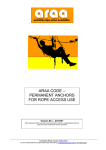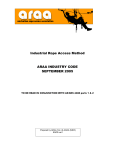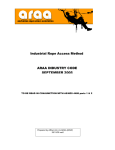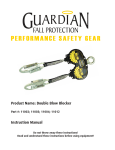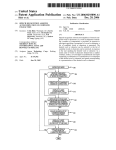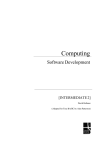Download - Australian Rope Access Association
Transcript
AUSTRALIAN ROPE ACCESS ASSOCIATION ACN 146 138 749 UNIT 10/87 RESERVE ROAD ARTARMON NSW 2064 www.araa.net.au [email protected] DISCLAIMER - Whilst every care has been taken in the preparation of this document, users are advised to seek expert advice regarding specific projects – ARRA accepts no responsibility for any error or omission resulting from use of this information. ANCHOR & SYSTEM INSPECTIONS / RE-CERTIFICATIONS This document is written to provide information regarding requirements for design and on-going inspection / testing of anchor points used widely by the industrial rope access community but also by the harness based working at height industry. In many instances, these two industries merge so it is appropriate to consider their requirements together. 1.0 EXECUTIVE SUMMARY Clients regular request an inspection or re-certification of an anchor installation when in fact, they need an entire new engineering assessment of an installation that may never have been designed or installed properly in the first place. The issue is often exacerbated by a lack of original design information or user documentation. On-going inspections of anchor systems end up falling into 3 categories: 1.1 Simple inspection and re-certification (including testing on occasions) of a properly installed and documented system. 1.2 Inspection and re-certification of a properly installed system but which has lapsed in regular inspections. In this case, some engineering involvement may be required to ensure the system is suitable for continuing use. 1.3 Complete re-evaluation of existing systems with an unknown or questionable background which will invariably require engineering involvement and which may well lead to significant changes being required. 1|Page 130821_ARAA_Anchors systems inspections and testing 2.0 TERMINOLOGY There is a common issue with anchor and fall protection systems when they fall due for their annual inspection. (Note in some jurisdictions there is some controversy over whether inspection is required at 6 monthly or 12 monthly intervals) The terminology gets very confused and the understanding of what is being requested or supplied is equally confused. Below we’ll discuss some specific words and their implications in the Standards and Regulations. The words commonly mis-used or mis-understood, in relation to anchor inspections, are: • • • • • Inspection Testing Certification Re-Certification Compliance Firstly, it is ASSUMED that compliance is being claimed or required against one of several Australian/New Zealand Standards. These are as follows: • • • • AS/NZS 1891.1;2007 AS/NZS 1891.2;2001 AS/NZS 1891.4;2009 AS/NZS 4488.1&2;1997 It must be underlined that these Standards are not LAW as they are voluntary compliance Standards. Generally, persons in charge of workplaces will make these Standards “law” (or more properly, requirements of the contract) by quoting them in their invitation to price or discussions with potential suppliers. It’s a smart move for the person in charge to do so as it provides a “line in the sand” of minimum requirements but it must be noted that there are times where the requirements of the Standard MAY need to be slightly compromised – this should only be done with the full knowledge of the person in charge of the workplace and the supplier and should be written down and justified so records exist. Two examples of when this may take place, may be a compromise in the method of fixing accompanied with engineering validation (i.e. Use of drilled in anchors outside the scope of the Standard), or the use of equipment that does not meet the corrosion requirements of the Standard. 2|Page 130821_ARAA_Anchors systems inspections and testing Must a Standard be followed? Documents such as Australian / New Zealand Standards, along with Codes of Practice from Workplace Authorities and Industry bodies provide a clear indication of what the current “state of knowledge” is and these documents will likely be referred to by a court of law in the event of a prosecution following an incident. As such, not following Standards is legal and possible, but must be done so with great care and only after providing equivalent or better safety – it is wise to record such decisions in writing! In line with the above, it is assumed also, that compliance with any relevant Industry Codes will be required by the person in charge of the workplace. At present, the obvious Industry Codes for rope access are: • • ARAA Industry Code ARAA Anchor Code – this document is specifically about anchors and as such, should be used on every rope access anchor installation Note that the ARAA also provides a comprehensive “compliance pack” for use by building managers and installation contractors. This 9 page pack is available from the ARAA website www.araa.net.au and provides a clear path to ensure all ARAA recommendations are met when designing and installing an anchor system. 3.0 REQUIREMENTS The various Standards and documents listed above all vary slightly in their stated requirements. There is a 10-15 year span across when the first and last were written and this is reflected in the set out requirements. Further, to this point, there has been great concern about the safety of using anchors that are drilled in to concrete or masonry. This includes both epoxy and mechanical (expanding) anchors. These concerns lead to the current documents presently forbidding the use of drilled in anchors in direct tension (pull out) While this position is currently under review, at the current time, any anchor that has been installed where it is used in axial tension (pull out) and where adequate additional justification has not been provided, clearly does NOT comply with the above documentation and any claim of compliance is incorrect. This conservative position has been adopted not because of any doubts about the fixing products but because of large doubts and experience related to the poor quality of many installations and further, because of degradation of substrates. The quality of products on the market is generally excellent – this does not seem to be matched by many anchor installation designs or installation works! 3|Page 130821_ARAA_Anchors systems inspections and testing 4.0 INSTALLATION OF DRILLED IN ANCHORS The appendices contain excerpts from AS/NZS 4488 (rope access), AS/NZS 1891.2 & supplement 1 (horizontal life lines and rails) and AS/NZS 1891.4 (selection and safe use). These three documents all require that: a) Any drilled in anchor (mechanical or epoxy) is used substantially in shear and most definitely NOT in axial tension (direct pull-out), and b) That any drilled in anchor be load tested before use to half the design anchor load, applied as an axial force 5.0 SERVICING / INSPECTION All three documents also stipulate that during annual inspection, any drilled in anchor be load tested as well. Post installation We are regularly asked about the correct process when a client calls an inspection company in, long after an installation has been completed. I.e. to verify an existing installation. Typically, the system may have been in place for some years and possibly, the required annual servicing/inspection has not taken place or perhaps has been carried out incorrectly Is the subsequent visit by an “inspector” intended to simply say the system is ok to use or is it effectively re-certifying the system – i.e. taking responsibility for the entire design and even installation? This needs some background. The initial installation SHOULD be accompanied by documentation. An example of what ARAA would expect is set out in the ARAA Anchor Code. See appendix for example. The ARAA Anchor Code is a document that would most certainly be used as an indication of industry “best practice” for ANY installation that took place after October 2007 and the ARAA advises its members to not work on anchor systems that do not meet this criteria. On anchor installations for harness based working at heights, there is presently a lesser amount of information on expected outcomes available however, AS/NZS 1891.4;2009, says a lot about how anchorages (including HLLs) should be installed and configured and in addition, the following excerpt sets out what information should be available to the operator – in many cases, this is not provided: PTO 4|Page 130821_ARAA_Anchors systems inspections and testing AS/NZS 1891.4;2009 excerpt: 3.2.5 Signs at anchorage points Signs in accordance with Clause 2.2.9 shall be provided for each anchorage point which will be in place for a period longer than one month. The sign shall show the following information: (a) Name of installer and installation date, or if an existing structure has been certified, the name of the certifier and the certification date. (b) The highest purpose category in Table 3.1 for which the anchorage is suitable. (c) The ultimate strength rating if less than 15 kN. In this case words to the effect that the anchorage is not to be used for fall-arrest shall be added to the sign. (d) The maximum number of people (not more than two) who are permitted to be connected to the anchorage at any one time. If an anchorage point is to be used only for a period of less than one month and is not therefore labelled, it shall be removed as soon as it is no longer required. At permanent installations the information shall be shown either on a sign located at each anchorage point or alternatively, on a plan prominently displayed at the entry to the area. 9.4.3 Re-entry into service after a period of storage or out of service Before use, each item shall be inspected as specified in Clause 9.3 after a period of storage or out of service in excess of the nominated inspection or service interval for that item, or where the item has been stored under conditions suspected of adversely affecting its condition. This requirement also applies to fixed or permanent installations when used less frequently than the maximum inspection interval. It will be seen that even for the anchor systems provided for harness based working at heights, some minimum information is required. In the case of rope access anchorages, the ARAA Anchor Code requires specific information to be supplied which includes: • Designers and installers contact details • Engineering information relating to the anchor AND the installation • Testing information • User instructions • Layout of the system and its intended manner of use • Specific servicing and testing requirements • Public protection expectations and a number of other specific pieces of information related to the actual site. 6.0 TESTING / INSPECTION OR VERIFICATION? When a servicing / inspection company arrives at a site, the expectation is that this information (above) will be available and their responsibility is to ONLY, certify (by inspection and testing where required) that the system, as installed, continues to be serviceable. If, however, all of the above information is not available, then the servicing / inspection company may effectively be asked to treat the system as a brand new installation for which they are being required to take responsibility for. 5|Page 130821_ARAA_Anchors systems inspections and testing This is a LARGE change in requirements and may expose both the tester and possibly the client, to unintended exposures. In fact, in some cases, the testing / inspection company may not be qualified or suitably insured for this additional responsibility. In many cases, this change of specification will almost certainly require the input of a suitably qualified AND experienced structural engineer to verify the “as installed” equipment and the substrate to which it is connected, is capable of taking the loads that may be applied to it in use. Before embarking on any works, in such a case, it is wise for the client and supplier to ensure there is a clear understanding of the scope of works as there can be a large time and cost difference between an inspection on the one hand and a re-certification on the other. 7.0 SITE INSTALLATION As set out in the ARAA Anchor Code, the “design and installation” of anchors for rope access comprises at least 3 different skill sets: • The design, fabrication and any type testing of individual anchor points. (i.e. Anchor points in a cardboard box/plastic bag, as supplied ready for installation) • The LAYOUT of a system suitable for use by rope access operators – this generally requires the input of a rope access supervisor • The Engineering knowledge and experience to properly overview the installation of anchors into specific locations on the structure – this is the area where the structural engineer may be critical Only when the above “design” issues are in place, can the actual installation works proceed and even in this area, there may be specific skills required such as welding, carpentry, use of drill in anchors, plumbing (sealing roof areas) etc. Clients would be well advised to ensure their installers have the entire range of skills available to them, and are adequately insured for the range required, before giving a go-ahead on works. SUMMARY When an existing installation is being inspected simply as an on-going process and existing documentation validates the design and installation works, it is reasonable to call this an inspection. If however, no records exist for the initial installation, then this should largely be treated as a new work and some engineering overview will almost certainly be required. The “inspection” provider is effectively taking responsibility for their design and installation of the works and as such, should carry out a comprehensive inspection and design review to provide adequate evidence that the works are safe. 6|Page 130821_ARAA_Anchors systems inspections and testing In the case of an installation that has records, but has not been regularly inspected (and tested when necessary) the inspection provider must make an assessment of the site and will generally err on the conservative side. This will often lead to some engineering input to verify the site is largely as it was at the time of installation. The final case is when an inspection company is requested to inspect/test the works that were installed by others. This can often raise questions about the quality of the initial works. The client must make a judgment here as to how many “doubts” are commercially based and how many are valid. Where testing is required, it MUST be carried out in a manner as set out by the original designer unless this advice has been proven to be faulty. Many serviceable installations have been damaged by inappropriate on-site testing! Finally, the client needs to exercise great care. In many cases, the inspection company (and installation company for that matter!) are NOT suitably qualified or insured for the level of works they are undertaking. The advice is simple – ask questions and take photocopies! 7|Page 130821_ARAA_Anchors systems inspections and testing APPENDICES • • • • • A - Extract from AS/NZS 4488.2;1997 – Anchorages (Rope Access) B - Extract from AS/NZS 1891.2;2001 – Horizontal lifelines and rails C - Extract from AS/NZS 1891.4;2009 – Selection and safe use D - APPENDIX - ARAA code - permanent anchors. Ver #1e 22/10/07 E - APPENDIX – Anchor inspection guidelines 8|Page 130821_ARAA_Anchors systems inspections and testing APPENDIX A Extract from AS/NZS 4488.2;1997 – Anchorages (Rope Access) 5.3 Anchorages Selection of the type of anchorage will depend on the nature and location of the task and the type of construction of the building or supporting structure. The following is a summary of these types of anchorages and their applications: (a) Anchorages suitable for the direct connection of lines Requirements and recommendations for the selection and location of anchorages are as follows: (i) The anchorage and the structure to which it is attached shall be capable of sustaining an ultimate load of 12 kN when loaded in the direction of the rope pull during industrial rope suspension work. The building or structure and anchorages shall be assessed by an engineer, unless it is clear to a competent person that the anchorage system is structurally adequate. An example of where an engineer may not be required is where an anchorage sling of the correct capacity is secured around a solid permanent structure such as a plant room. However, if any doubt exists as to the structural adequacy of the anchorage, an engineer shall make the assessment. Dynamic loads under fall-arrest conditions can be considerably higher than the static loads. If called upon to make the assessment the engineer shall certify in writing that all combinations of loads in a worst case situation can be safely contained by the proposed structure and anchorage points. (ii) In addition to the assessment made in Item (i), drilled-in, glued-in and friction anchorages (see Item (viii)) shall be proof loaded by application of an axial pull-out force of 6 kN after installation and as part of subsequent periodic inspections (see Clause 7.1.3). Records of such proof loading shall be kept with the building owner or manager for reference by subsequent users of the anchorage. (iii) At each permanently installed Identifying the installer, shall be provided. anchorage a permanently fixed plate (iv) Where the anchorage point is not capable of sustaining an ultimate load of 15 kN in the direction of loading as a fall-arrest anchor, it shall be permanently labeled as follows: For industrial rope access only. Ultimate strength less than 15 kN. Check with (building, structure, and the like) owner before use. Absence of a label as specified above should not be grounds for assumption by any user of the anchorage that it is capable of sustaining a 15 kN load, without first checking with the owner of the structure. NOTE: The specified minimum load on an anchorage for rope suspension purposes is 12 kN. This is derived as the maximum design tensile force developed in an energy absorber, multiplied by a safety factor of 2. This minimum load does not apply to slings (see Item (b). (v) Ropes shall be able to be attached to the anchorages and the operator attached to the ropes before moving into a position where there would be risk of a fall. (vi) Possible deterioration of anchorages, e.g. that caused by atmospheric conditions, should be considered. 9|Page 130821_ARAA_Anchors systems inspections and testing (vii) The risk to the operator from any machinery or any opening of a window, door or panel, should be considered. (viii) Where used, drilled-in, friction and glued-in anchorages shall be placed so that the shear load is at least twice the tension load. For collared eye-bolts this translates to a pull at an angle not exceeding 20 degrees to the surface in which the bolt is installed. (ix) Any specific requirements of the manufacturer of the anchorage system or other related equipment shall be able to be met. (b) Anchorages requiring use of a sling Anchorages are as follows: Requirements for the selection and location of (i) All relevant requirements in Items (a)(i) to (ix) shall be observed except that a sling shall always be selected and rigged for an ultimate load in the direction of loading of at least 15 kN. (ii) The sling shall be of sufficient length so that it can be rigged with the angle between the legs no greater than 120 degrees (see Clause 6.3), unless allowance has been made for the higher loads which would be imposed by a greater angle. 7.1.3 Periodic inspection of anchorages permanently installed anchorages shall be inspected by a competent person at intervals not exceeding 12 months. Adequate inspection records shall be kept. Wherever practicable a plate indicating the date of the last inspection should be placed near the anchorage. Inspection of drilled-in, glued-in or friction anchors shall include the following: (a) (b) Proof loading by application of an axial pull-out force of 6 kN. Inspection requirements given in manufacturer’s instructions. Note that it has become commonplace to a/ design rope access anchors to the 15 kN figure required for harness based working at heights and to test to 7.5 kN Min. as a result. 10 | P a g e 130821_ARAA_Anchors systems inspections and testing APPENDIX B Extract from AS/NZS 1891.2;2001 – Horizontal lifelines and rails 2.5.3 Drilled-in anchorages Drilled-in anchorages such as friction and glued-in anchorages shall only be used if they are installed in a position so that the shear load is at least twice the tension load. For an anchorage device inserted at right angles into a surface, this translates to a pull at an angle not exceeding 20 degrees to the surface. Extract from AS/NZS 1891.2 Supplement 1:2001 8 INSTALLATION 8.1 Structural anchorage point Structural anchorage points including all brackets and fittings shall be designed and installed to meet the design ultimate strength specified in the system design parameters set out in Clause 6. They shall meet the following requirements: (a) Provision of new anchorage points shall be either by engineering design or assessment of a proposed anchorage structure by an engineer or other competent person. (b) An installed structural anchorage point shall be certified by an engineer or other competent person and shall be proof tested if that person so requires. Installation and proof testing documentation including the engineer's certificate shall be kept in situ for the duration of the works at a short-term installation and with the building or structure management in the case of long-term installations. (c) Drilled-in anchorages such as friction and glued-in anchorages shall only be used if they are installed in accordance with manufacturers' instructions and are in a position so that the shear load is at least twice the tension load. For an anchorage device inserted at right angles into a surface, this translates to a pull at an angle not exceeding 20 degrees to the surface. Following installation the anchorage point shall be proof-loaded in all cases by means of an axially applied pull-out load equal to— (i) at least 50% of the design ultimate end anchorage load as specified in Clause 6.1(a)(i), for an end anchorage; or (ii) 6 kN in the case of an intermediate anchorage provided in accordance with Clause 6.1(b). (d) Anchorage points shall be provided with information by an appropriate means designed to provide adequate legibility over the entire period of use, as follows: (i) For systems likely to be in use for 6 months or longer—a system information plate shall be displayed at each regular entry point to the system. The plate shall provide the following information: (A) Manufacturer’s and installer’s name and installation date. (B) A unique identification number. (C) An instruction that a personal energy absorber or a fall-arrest device with energy absorbing properties must be used. (D) Any special instructions for use, including the number of users allowed on the system or on any one span at once. (E) Servicing requirements and instructions, together with inspection and servicing intervals and the dates on which they are to be carried out. 11 | P a g e 130821_ARAA_Anchors systems inspections and testing (F) The month and year by which the system should be taken out of service unless it has been re-certified by a competent person in accordance with manufacturer’s instruction as safe for continued use. This date shall be not more than 10 years from the date of original installation nor more than 5 years from any subsequent re-certification. The plate shall be made from tamper resistant material and installed so as to retain the information in legible condition for the expected life of the installation. (ii) For a shorter term use—the same information required in Item (i) shall be provided but such provision may be by a less permanent means than a plate, e.g. a paper or cardboard notice in a plastic sleeve secured to a point near the anchorage. The time periods in Item (i)(F) shall be shortened to a period not exceeding 6 months. 12 | P a g e 130821_ARAA_Anchors systems inspections and testing APPENDIX C Extract from AS/NZS 1891.4;2009 – Selection and safe use 3.1.2 Single point anchorages suitable for direct connection of personal fall-arrest equipment In addition to any specific requirements of the manufacturer of the anchorage system or other related equipment, the following requirements and recommendations for the selection and location of anchorages apply: (a) The anchorage and the structure to which it is attached shall be capable of sustaining an ultimate load equal to that shown in Table 3.1 for the corresponding anchorage purpose for single person use when loaded in the direction of the lanyard, anchorage line, or restraint line during a fall arrest. This load requirement shall be increased by 6 kN (i.e. to 21 kN) if two people are to use the one point. The maximum number of people connected to any one point shall be two. As far as practicable, all single-point anchorages for single-person attachment should have an ultimate strength of 15 kN even though Table 3.1 specifies a lesser strength for some categories. The building or structure and anchorage points shall be assessed by an engineer, unless it is clear to a height safety supervisor that the anchorage system is structurally adequate. An example of where an engineer may not be required is where an anchorage sling of adequate strength is secured around a solid permanent structure such as a plant room. However, if any doubt exists as to the structural adequacy of the anchorage, an engineer shall make the assessment. If called upon to make the assessment the engineer shall certify in writing that all combinations of loads in a worst case situation can be safely contained by the proposed structure and anchorage points. (b) The following conditions shall apply to the use of anchorages in each of the purpose categories listed in Table 3.1: (i) Free fall-arrest Required in any situation where a free fall in excess of 600 mm is a possibility. (ii) Limited free fall-arrest Limited to any situation where there is no risk of a free fall in excess of 600 mm. (c) Signage in accordance with Clause 3.2.5 shall be provided. (d) Fall-arrest anchorages shall, except as given below, be located in positions where there is adequate fall distance before the user can strike a lower obstruction, having regard to the fall-arrest equipment likely to be used (see Section 7). Examples include striking any machinery or open window, door or panel during a fall. If it is not possible to provide clearance from all obstructions a person might strike, the requirements of Section 7 shall be observed. (e) Lanyards or anchorage lines shall be able to be attached to the anchorages before the operator moves into a position where there would be risk of a fall, unless the operator is already protected by another fall-arrest system. (f) Possible deterioration of anchorages or substrate damage, e.g. That caused by chemical attack, corrosion or atmospheric conditions, should be considered in selecting the anchor material and design. (g) Where used, drilled-in anchorages such as friction and glued-in anchorages shall be placed so that the shear load is at least twice the tension load. For collared eye-bolts this translates to a pull at an angle not exceeding 20° to the surface in which the bolt is installed. Every friction and glued-in anchorage shall be proof loaded to 50% of the design ultimate strength specified in Table 3.1 in accordance with manufacturer’s instructions after installation and prior to its initial use. The proof load shall be applied as an axial pull-out force. Proof loading to 50% of design load shall also be carried out as part of subsequent periodic inspections. 13 | P a g e 130821_ARAA_Anchors systems inspections and testing APPENDIX D APPENDIX - ARAA code - permanent anchors. Ver #1e 22/10/07 ANCHORS – DOCUMENTATION AND MARKING ROPE ACCESS PERMANENT ANCHOR SYSTEMS DOCUMENTATION AND MARKING REQUIREMENTS Any permanent rope access anchor system, (intended to be left in place for permanent use) following installation, should be supplied with documentation that is kept on site by building management and should be made available to any rope access crew prior to works proceeding. This documentation should include at least the following information: • • • • • • • • • • • • • • • • Installing person/company, date of installation and full written instructions to enable anchor system to be understood by a competent rope access operator An initial risk assessment Any details required to indicate servicing and maintenance requirements for the installation Testing information, if any, relevant to the installation Contact details to the installing person/company and any additional Engineering body Plan of area of anchors (generally a roof plan) and to include rigging plan for all drops/anchors Location of all anchor points with marking to show intended use (i.e. Main anchor, diversion etc.) and intended direction of loading A statement setting out the purpose of the designer in choosing anchor locations – i.e. are they for general façade access, window cleaning only, gutter cleaning etc. Definition of whether anchor is within the zone of 2m from an edge or potential fall zone Where anchors are placed on façade or vertical surface of structure for purposes of re- anchor (re-belay), diversion, deviation or lateral stability, an elevation should be shown for each face with location and purpose of each anchor shown. Where the users are required to supply/use additional equipment such as slings, the details of this requirement should be set out to clearly define what length, rating, configuration etc. is required. Additionally, if such rigging requires the use of a Rigging qualification, this should be noted. Requirements for public protection in conjunction with the works – in some cases this may require drawings and on occasions, special equipment, permits etc. Requirements for any special protection needing to be placed or supplied by the operatives, to protect the building, the equipment and the operators. Details of any special requirements that are unusual for a competent rope access crew Anticipated rescue plan and any special details, equipment or skills that are expected of the crew in relation to this plan The minimum Supervisor level required for the works and where relevant, the minimum team size required to carry out anticipated works (note, works may later arise that utilise the anchor system in a manner that differs from that specified in the user manual – in such cases, it is the responsibility of the Supervisor to document these differences and to assess the system’s capacity to deal with these new circumstances) 14 | P a g e 130821_ARAA_Anchors systems inspections and testing All permanent anchor points should be marked with the following information. This should, where practical, be fixed to or at, each anchor but may, in some cases be fitted at one location such as the access door to a roof. A case where it is understood that individual anchors may not be able to be individually marked, is those on a façade where they may cause aesthetic issues. Irrespective of this, all anchors should be marked with at least a serial No or batch No to enable traceability of individual anchors. Subject to the above comments, marking should include: • • • • • Manufacturer’s contact Installer’s contact Load rating and direction. Specific use if not also suited as a fall protection anchor (min. 15 kN ult) Most recent inspection/service date Following any incident such as a fall, affected anchors should be tagged and withdrawn from service until engineering assessment/inspection has been carried out by a competent person and the anchor replaced/repaired or re-certified. The documentation supplied for use on site by the installation person/company should be signed by an individual of that body as the person taking responsibility for the proper design, specification and installation of the works. Note that the ARAA also provides a comprehensive “compliance pack” for use by building managers and installation contractors. This 9 page pack is available from the ARAA website www.araa.net.au and provides a clear path to ensure all ARAA recommendations are met when designing and installing an anchor system. 15 | P a g e 130821_ARAA_Anchors systems inspections and testing 16 | P a g e 130821_ARAA_Anchors systems inspections and testing
















